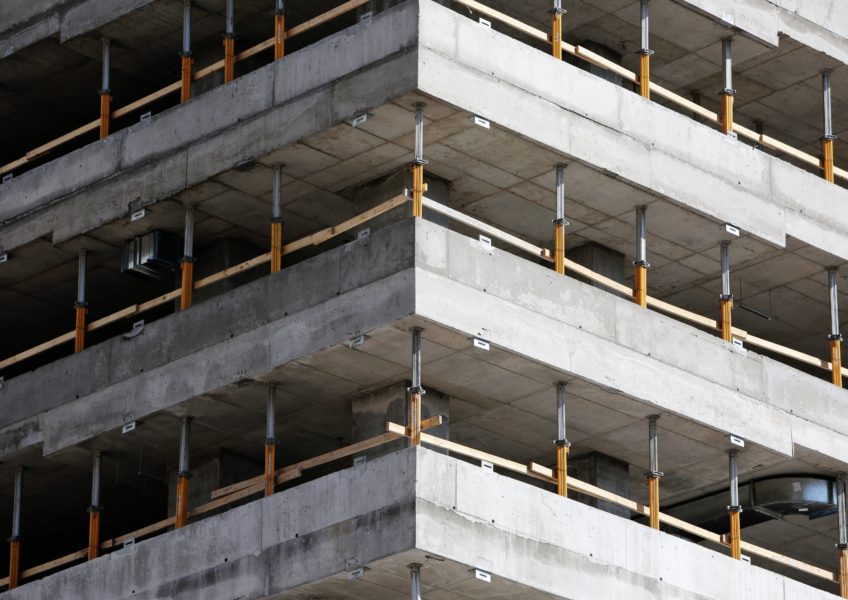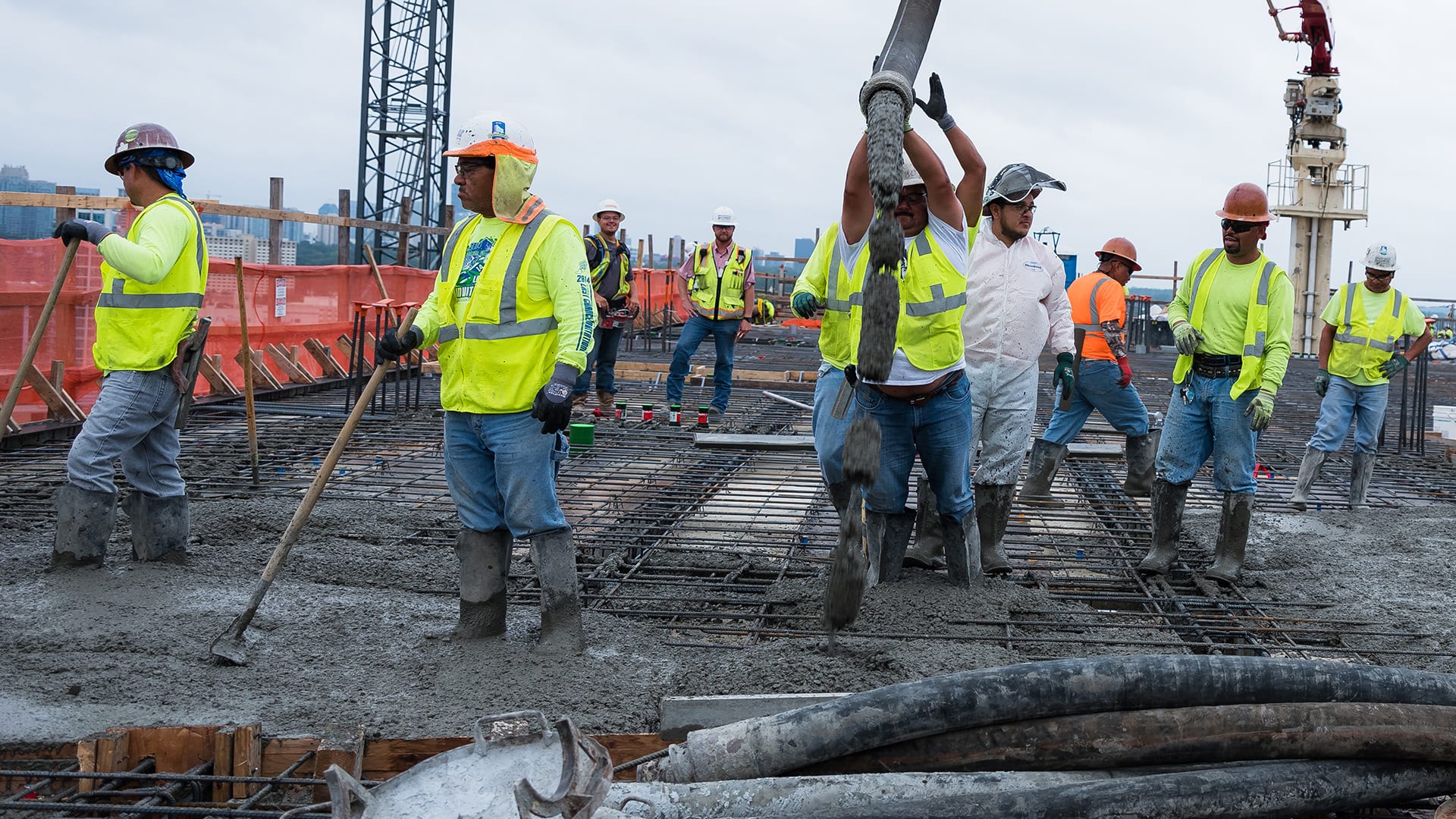The Essential Role of Concrete Foundation in Structural Integrity and Longevity
When it concerns developing a residential property, the structure is extra critical than you could assume. Concrete structures give unmatched toughness and durability, ensuring your framework can withstand various environmental challenges. Without a solid base, you risk prospective problems like shifting or cracking, which can compromise safety and security and worth. Comprehending the nuances of concrete foundations can be the secret to protecting your investment for years ahead. What should you think about next?
Understanding the Significance of Concrete Foundations
Concrete foundations are essential to the total security of any type of structure, as they provide the important support needed to withstand numerous lots and ecological conditions. When you think of developing a home or a commercial area, the foundation is the first thing you should take into consideration. It functions as a barrier versus dampness, securing your residential or commercial property from water damages. A well-placed concrete structure likewise stops settling and moving, which can result in cracks in wall surfaces and floorings. You'll wish to ensure that the foundation is effectively developed and strengthened, as this affects the durability of your building. Furthermore, a solid structure can improve power efficiency by minimizing air leaks. Remember, neglecting the value of a concrete foundation can cause pricey repairs down the line. Investing in a quality foundation upfront is necessary for the honesty and toughness of your structure.
Benefits of Concrete Structures for Architectural Integrity
While numerous variables add to a building's architectural integrity, concrete foundations use unrivaled resilience and toughness. You'll appreciate that concrete can hold up against severe weather, resisting both moisture and temperature level fluctuations. This strength indicates your framework is much less most likely to experience breaking or changing in time, which can jeopardize its safety.Additionally, concrete's fundamental weight gives a solid base, stopping movement during natural occasions like earthquakes or floodings. When you choose a concrete structure, you're also selecting reduced upkeep; unlike wood, it will not rot or draw in pests, saving you time and money in repairs.Moreover, concrete's fire resistance uses included safety, ensuring your structure can endure high temperature levels without significant damages. In general, buying a concrete structure means you're focusing on the lasting stability and stability of your structure, making it a wise option for any kind of building task.
Typical Kinds Of Concrete Foundations
When it involves building structures, recognizing the common kinds of concrete foundations can assist you make informed selections for your job. The most prevalent types consist of slab-on-grade, crawl room, and full cellar foundations.A slab-on-grade structure is a basic, economical choice, where a thick concrete slab is poured straight on the ground. This type functions well in cozy environments, as it minimizes heat loss.Crawl area structures elevate the home slightly above ground, enabling for air flow and accessibility to plumbing and electric systems. This style can aid prevent moisture issues.Full cellar foundations supply extra living or storage room while giving outstanding architectural support. They need even more excavation and are normally used in chillier environments to stop frost heave.
Factors to Think About When Creating a Concrete Foundation

Best Practices for Setting Up Concrete Foundations
When you're mounting a concrete foundation, appropriate website preparation is necessary to assure stability (West Coast General Engineering industrial concrete Rancho Cucamonga). You'll also need to comprehend reinforcement methods to boost toughness and sturdiness. Lastly, do not forget the curing process, as it plays a fundamental function in accomplishing a strong structure
Site Preparation Value
It might seem simple, proper site prep work is essential for assuring a solid and long lasting concrete structure. Begin by removing the area of any debris, vegetation, or natural product that could endanger the foundation's honesty. Next, assess the dirt type and compaction; you could need to dig deep into or include materials to produce a stable base. Degree the ground to guarantee also weight distribution and stay clear of clearing up issues later. Installing correct drain systems is additionally important to prevent water build-up, which can weaken the structure over time. Ultimately, mark out the foundation's measurements precisely to guide the putting process. By following these actions, you'll establish the stage for an effective concrete foundation that stands the test of time.
Reinforcement Strategies Discussed
When the site is appropriately prepared, the following step in assuring a durable concrete structure entails implementing efficient support strategies. You ought to begin by using steel rebar, which gives tensile strength and assists prevent splitting. Lay the rebar in a grid pattern, ensuring it rises making use of spacers to maintain appropriate insurance coverage. In addition, consider utilizing cord mesh for extra support, specifically in areas based on hefty loads. Do not forget to connect the rebar intersections safely with cord. For bigger structures, fiber support can improve toughness, decreasing the danger of contraction splits. Always comply with local building ordinance and standards to make certain conformity. By applying these support methods, you'll considerably improve your foundation's strength and long life, laying a strong foundation for your framework.
Curing Refine Basics
To assure your concrete structure remedies correctly, it is very important to maintain adequate dampness and temperature level problems right away after pouring. Start by covering the surface area with a damp burlap or plastic bed linen to preserve wetness. This keeps the concrete moisturized, protecting against fractures and guaranteeing strength. You need to likewise keep track of the temperature level; excellent healing conditions are between 50 ° F and 90 ° F. If it's also hot, haze the surface area consistently to stop quick evaporation. For winter, think about using insulating coverings to preserve warmth. Purpose for a treating period of at the very least seven days, as this is vital for ideal strength advancement. By following these finest practices, you'll improve your structure's toughness and longevity, making sure structural stability for years to find.
Upkeep of Concrete Foundations for Durability
To maintain your concrete foundation strong and long-term, regular assessments are important. You must also ensure reliable drainage options remain in place to protect against water damage. If you find any kind of cracks, addressing them immediately will conserve you from bigger issues down the line.

Regular Inspections and Analyses
While routine evaluations and assessments could look like a task, they're essential for keeping the stability of your concrete foundation. By consistently inspecting for cracks, changes, or indications of wear, you can catch potential concerns before they escalate right into costly fixings. Try to find any water merging around the foundation or uncommon settling, as these can indicate underlying problems. It's additionally important to keep track of any kind of modifications in your home's framework, like doors that stick or windows that do not open smoothly. Maintaining a record of your examinations helps track adjustments gradually, enabling positive upkeep. Ultimately, these analyses guarantee your structure remains secure, supporting the long life and safety of your entire framework. Don't overlook this important aspect of homeownership!
Reliable Drainage Solutions
Normal evaluations can expose concerns like water drainage problems that might compromise your concrete foundation's stability. To stop water accumulation, assure your gutters and downspouts direct water away from the structure. Installing French drains pipes can effectively redirect surface and groundwater, lowering stress on your foundation walls. Furthermore, rating the dirt around your home aids assure that water flows away, as opposed to pooling near your foundation.Consider utilizing sump pumps in locations vulnerable to flooding, as they proactively get rid of excess water. Routinely inspect for blockages read review in drain systems and clear them without delay. You'll shield your structure's integrity and longevity by taking these proactive measures. Remember, effective drainage services are vital for preserving a strong, resilient concrete foundation.
Trigger Crack Repair Works
When you discover cracks in your concrete foundation, addressing them promptly is essential for preserving its durability. Small cracks can quickly advance right into bigger issues, compromising the architectural integrity of your home. Routinely examine your foundation for signs of damage, such as straight or upright fractures. If you spot any type of, don't from this source wait-- repair them immediately. You can utilize epoxy injections or concrete patching compounds, which are reliable for sealing fractures. Always adhere to the supplier's directions and take into consideration consulting a specialist for considerable damage. Remember, timely repairs not just enhance your foundation's sturdiness but additionally conserve you cash over time by avoiding more considerable repairs down the line. Remain proactive, and your structure will certainly remain strong and protected.
Addressing Usual Issues With Concrete Structures
Concrete foundations can encounter numerous problems in time, making it critical to identify and address them without delay. One of the most typical problems is fracturing, which can take place due to temperature changes or clearing up dirt. If you see splits, it's necessary to examine their size and deepness; little fractures can usually be sealed, while bigger ones might require expert evaluation.Water intrusion is an additional major worry. Excess moisture can lead to mold and mildew development and architectural degeneration. Assurance correct drainage around your foundation to alleviate this danger. Furthermore, search for indications of changing or bowing wall surfaces, as this can indicate underlying problems with your foundation's stability.Regular inspections are fundamental to capture these problems early. If you detect any kind of concerning indicators, do not be reluctant to consult a structure specialist. By remaining proactive, you can maintain the integrity and durability of your concrete structure, assuring your home continues to be safe and safe and secure.
Often Asked Questions
Just How Does Dirt Kind Impact Concrete Structure Performance?
Soil kind significantly influences concrete foundation efficiency. If you've got expansive clay, as an example, it can create moving and breaking. Sandy dirt may cause clearing up. Recognizing your soil helps assure a steady structure.
Can Concrete Foundations Be Fixed if Harmed?
Yes, you can fix broken concrete foundations. Depending upon the degree of the damage, methods like epoxy shot or slab jacking can recover security. It's ideal to speak with an expert for effective remedies.
What Is the Normal Life-span of a Concrete Structure?
A concrete foundation normally lasts 30 to 100 years, official site depending on aspects like dirt conditions, climate, and maintenance. You'll want to maintain an eye on it to assure it continues to be healthy throughout its life expectancy.
Exist Choice Materials to Concrete for Foundations?
Yes, there are options to concrete for foundations, like steel, timber, or even recycled materials. Each choice has distinct advantages and downsides, so you must consider your job's specific requirements when selecting the ideal material.
Exactly How Does Climate Effect Concrete Foundation Durability?
Climate greatly influences concrete foundation resilience (West Coast General Engineering commercial concrete Rancho Cucamonga). Extreme temperatures, moisture, and freeze-thaw cycles can damage the material, resulting in fractures and structural problems. You need to take into consideration regional environment conditions when intending your foundation to guarantee long-lasting performance